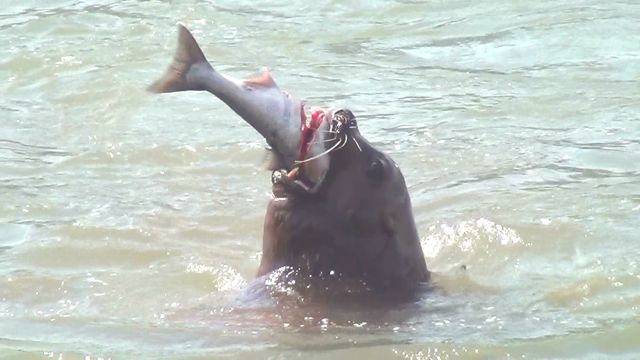forum
library
tutorial
contact

Recovery of West Coast Marine Mammals
Dramatically Increasing Consumption of Chinook Salmon
by Staff
Columbia Basin Bulletin, December 1, 2017
|
the film forum library tutorial contact |

|
Recovery of West Coast Marine Mammals
by Staff
|
 Recovering populations of killer whales, sea lions and harbor seals on the West Coast have dramatically increased their consumption of chinook salmon in the last 40 years, which may now exceed the combined harvest by commercial and recreational fisheries, a new study finds.
Recovering populations of killer whales, sea lions and harbor seals on the West Coast have dramatically increased their consumption of chinook salmon in the last 40 years, which may now exceed the combined harvest by commercial and recreational fisheries, a new study finds.
While the recovery of marine mammals represents a conservation success, it creates complex tradeoffs for managers also charged with protecting the salmon they prey on, the study concludes. The U.S. Marine Mammal Protection Act of 1972 protects all marine mammals, including whales and pinnipeds (seals and sea lions) within the waters of the United States. The Endangered Species Act protects nine West Coast populations of chinook salmon.
The study was published last week in the journal Scientific Reports. The findings resulted from a collaboration of federal, state and tribal scientists in the Pacific Northwest, including Oregon State University and NOAA Fisheries. The research was designed in part to understand the pressures on chinook salmon consumed by southern resident killer whales, which in contrast to other killer whale populations are endangered and show few signs of recovery.
Southern residents spend much of the year in the inland waters of Washington and consume about the same volume of salmon today as they did 40 years ago, the study found. The study suggests that, at least in recent years, competition with other marine mammals may be more of a problem for southern residents than competition with human fisheries.
"We have been successful at restoring and improving the population status of protected marine mammals," said Brandon Chasco, a doctoral candidate at Oregon State University and lead author of the study. "But now we have the potential for protected seals and sea lions to be competing with protected killer whales, and all of which consume protected chinook salmon."
The study used models to estimate marine mammal consumption of chinook salmon based on several assumptions about their diet and the size and weight of salmon. The researchers estimate that from 1975 to 2015, the yearly biomass of chinook salmon consumed by pinnipeds (sea lions and harbor seals) and killer whales increased from 6,100 to 15,200 metric tons, and from five to 31.5 million individual salmon.
Over the same time span, they found that annual fisheries harvest decreased from 16,400 to 9,600 metric tons, and from 3.6 million to 2.1 million individuals.
Overall, several growing populations of resident killer whales in Canada and southeast Alaska are estimated to consume the largest biomass of chinook salmon, but harbor seals consume the largest number of individuals, including juvenile chinook salmon, according to the study.
Salmon recovery programs underway up and down the West Coast have boosted numbers of wild salmon, the research found. However, increased predation by recovering marine mammals may be offsetting reductions in recreational and commercial harvests, and "masking the success of coast-wide recovery efforts," the scientists wrote.
Isaac Kaplan, a research fishery biologist at NOAA Fisheries' Northwest Fisheries Science Center and a coauthor on the study, said the researchers quantified only one of many challenges to chinook salmon recovery.
"The better we understand the different obstacles to salmon recovery, the better we can account for them as we plan and carry out recovery programs," Kaplan said. "Recovery efforts must account for all of these challenges, and we're providing more details about one important part of that picture."
The Columbia River has previously been identified as an area with high marine mammal consumption of salmon, specifically by seals and sea lions in the estuary. The researchers found that in 2015 in the Columbia River, harbor seals on the river consumed 14 metric tons of chinook salmon, compared to 219 and 227 metric tons consumed by California and Steller sea lions, respectively.
Considering the consumption of just adult chinook salmon in 2015, the researchers estimated that harbor seals consumed 1,000 adult chinook salmon, while California sea lions consumed 46,000, and Steller sea lions consumed 47,000.
"Consumption in the ocean is also a significant source of mortality, but has been largely unmeasured until now," said Chasco, a National Marine Fisheries Service-Sea Grant Population Dynamics Fellow in the Department of Fisheries and Wildlife in OSU's College of Agricultural Sciences. "Now managers have more information to work with in balancing these difficult tradeoffs."
Study collaborators included researchers at NOAA Fisheries' Northwest Fisheries Science Center in Seattle, Smith-Root, a fisheries conservation technology firm in Vancouver, Washington; Western Washington University; Makah Fisheries Management in Neah Bay, Washington; the Washington Department of Fish and Wildlife; and the North Gulf Oceanic Society in Homer, Alaska.
The Pacific Salmon Commission funded the study.
learn more on topics covered in the film
see the video
read the script
learn the songs
discussion forum
